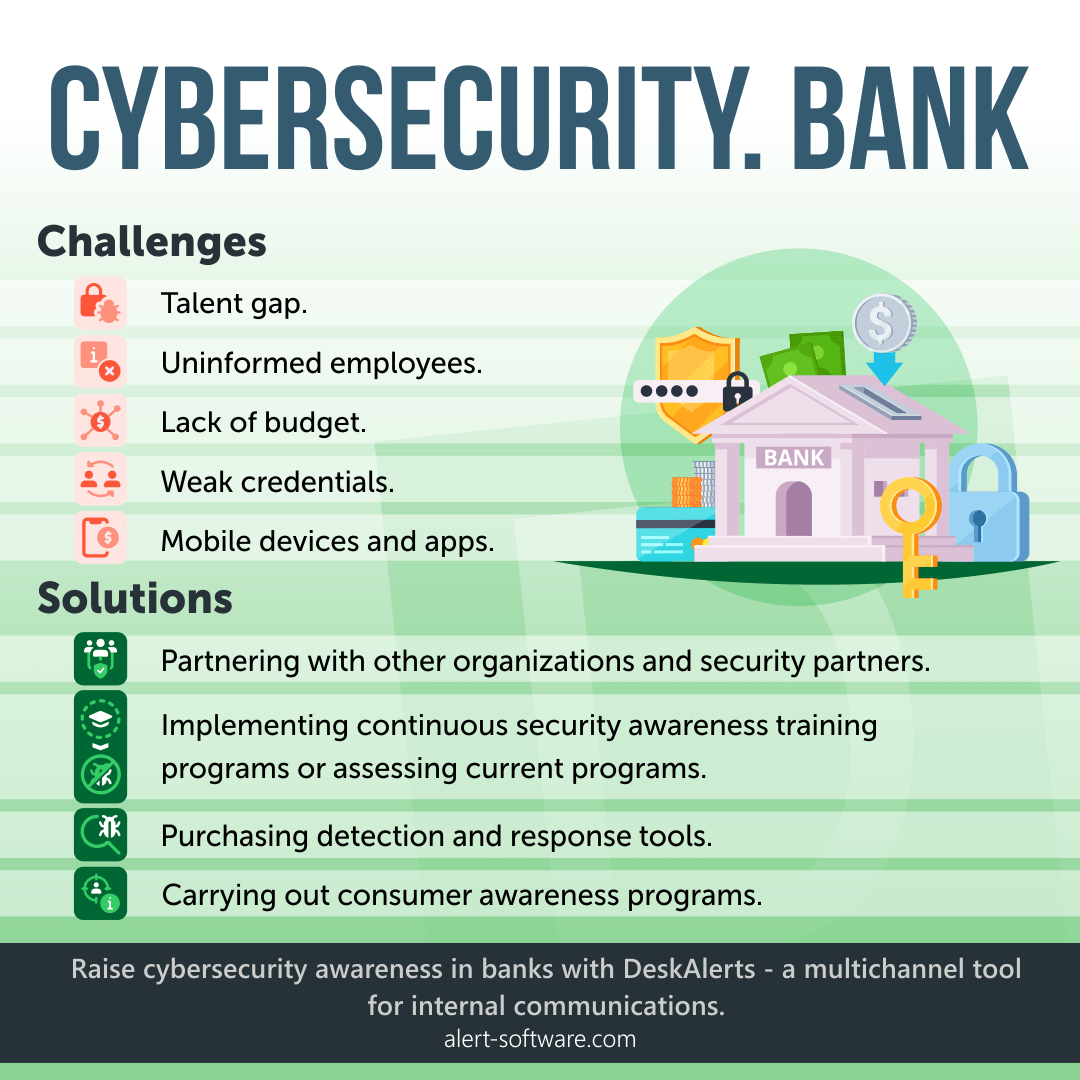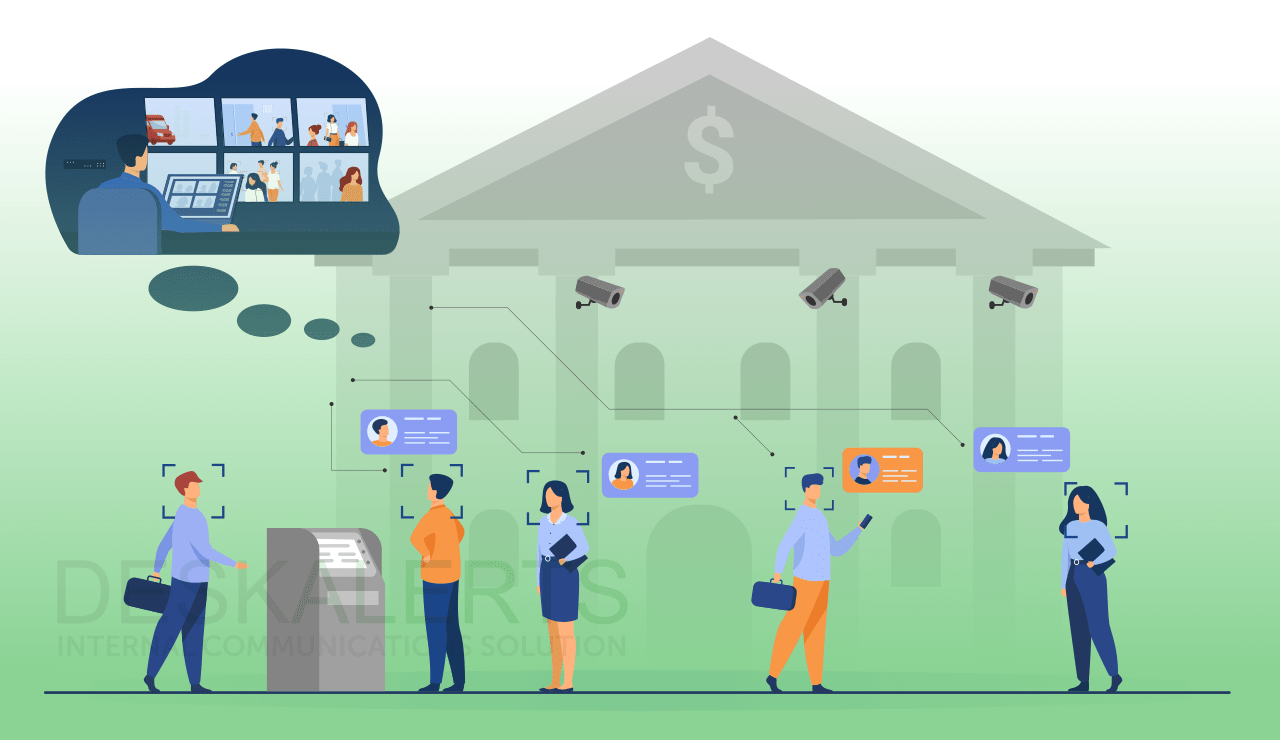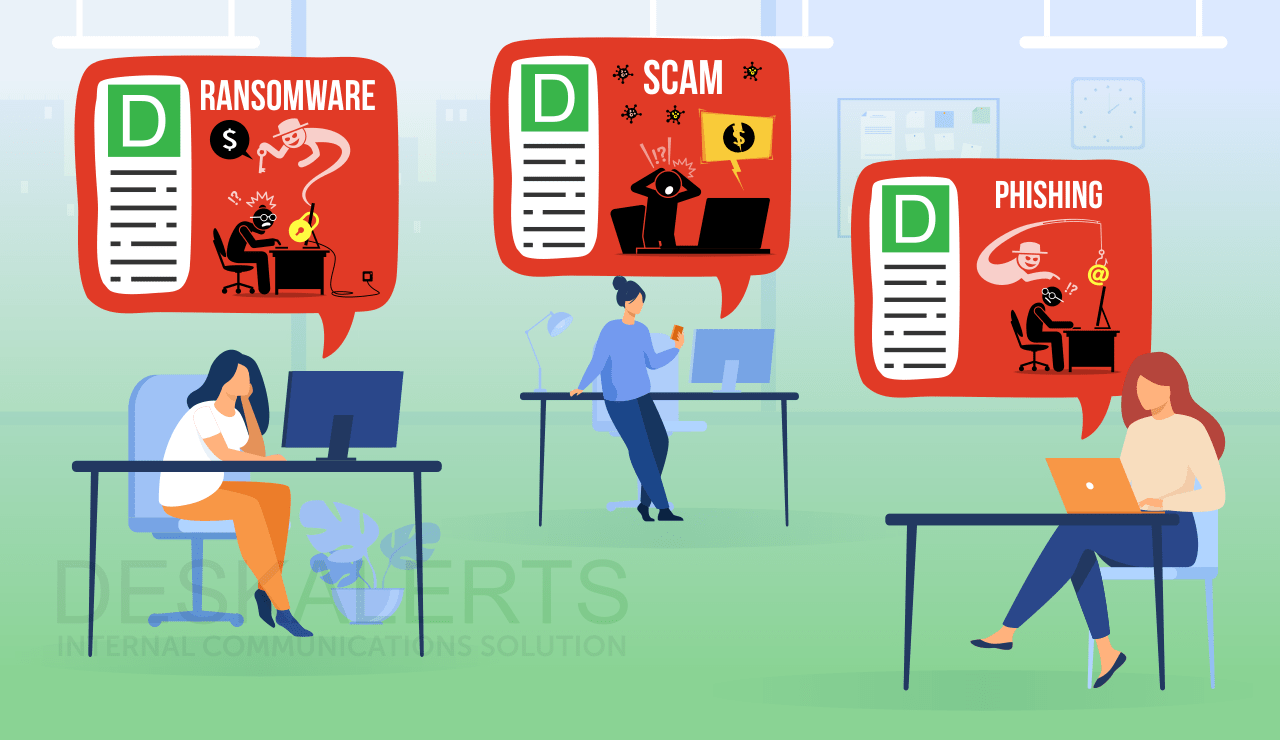
The cybersecurity landscape is always shifting, with threats becoming more sophisticated all the time. In the banking and financial sector, the stakes are high: not only are large amounts of money at stake, but when banks and other financial systems are compromised, the disruption to the economy as a whole can be significant.
A key priority for banks should be raising awareness of cybersecurity issues among employees and making the most of innovative communication tools, such as DeskAlerts, to cut through the digital noise and ensure that important information on cybersecurity topics is being received.
Table of contents
The Importance of Being Aware of Cybersecurity Trends
The Top Cybersecurity Threats In 2025 for Banks
Examples of cybersecurity attacks in banks
Cybersecurity challenges banks face
Solutions to cybersecurity challenges in banking
Importance of communication
THE IMPORTANCE OF BEING AWARE OF CYBERSECURITY TRENDS
According to a report from Trend Micro, in the first half of 2021 alone, ransomware attacks in the banking industry increased by a whopping 1318% which was disproportionate to other industries.
The New York Federal Reserve noted a report that financial firms experience cyber attacks 300 times more than other industries – highlighting how attractive this sector is to cybercriminals.
The main reasons to be vigilant around cybersecurity trends include:
- An increase in cashless transactions means that more financial transactions than ever before are digital.
- Weak cybersecurity in the banking sector can compromise customers.
- The cost of recovering from a breach can be enormous and time-consuming.
Staying informed about the risks of cybersecurity has been an important regulatory requirement for financial institutions in the United States, with new reforms coming into place in recent years.. Banks are now required to inform the federal regulator about any incidents that have occurred that can affect the viability of their operations or their ability to deliver services and products.
They’re also required to report anything that may potentially occur and anything that could affect the USA’s financial sector’s stability. These types of events include banking cybersecurity risks such as hacking, ransomware, and distributed denial of service (DDoS) attacks. Similar rules are also coming into effect in the UK, Europe, and Australia.
According to the American Bankers Association, eight out of 10 bank board members and executives that it surveyed said their bank had increased its tech budget in 2022 to invest in bank cyber security.
The Top Cybersecurity Threats in 2025 for Banks
These are the top cybersecurity threats that are predicted to continue to cause grief for banks and financial institutions over the course of 2025.
1. Ransomware
Ransomware has been a major headache for organizations around the world for several years now, and doesn’t look like stopping any time soon. This is a method of cybercrime where files are encrypted, and users are locked out, with the criminals demanding money to re-access the system.
Organizations affected by ransomware attacks can find their systems crippled for extended periods of time, particularly if they don’t have backups. Paying ransoms to these criminals is also not guaranteed to result in your systems access being restored.
2. Ongoing risks from remote work
As the pandemic enters its fourth year, the reliance on remote work, hybrid workforces, and cloud-based software systems has become almost ubiquitous. This also means that financial institutions have more potential cybersecurity vulnerabilities than ever before. Employees are no longer always accessing data on systems and networks that are controlled by the organization, so extra vigilance is necessary.
3. Cloud-based cyberattacks on the rise
As more software systems and data are stored in the cloud, cybercriminals have seized upon this, and as a result, an increase in cloud-based attacks has been one of the most prevalent cyber threats to the banking industry. Banks need to ensure that the cloud infrastructure is configured securely to protect from harmful breaches.
4. Social engineering
One of the biggest recent cyber threats to banking and finance is social engineering. People are often the most vulnerable link in the security chain – they can be tricked into giving over sensitive details and credentials. This can equally affect a bank’s employees or its customers.
Social engineering takes many forms, it might be through phishing or whaling attacks, or it could be by sending bogus invoices that purport to be from a trusted source. It’s important to keep your employees informed about social engineering tactics and how these threats continue to evolve.
6 Cybersecurity Email Templates [+ Tips]
Increase Message Visibility and Prevent Cybersecurity Breaches. Download for free

5. Supply chain attacks
An increasingly popular method of malware distribution by cybercriminals is to target a software vendor and then deliver malicious code to customers and others in the supply chain in the form of products or updates that, on the surface, appear to be legitimate. These attacks compromise the distribution systems and enable the cybercriminals to enter the supplier’s customers’ networks.

Examples of cybersecurity attacks in banks
There have been many instances of cyberattacks on banks and other financial institutions over the past few years. Some of the biggest cyber attacks include:
- A ransomware attack on Flagstar Bank in the USA in 2020 where hackers posted personal details of the bank’s customers online to attempt to extort money from the bank.
- The New Zealand Stock Exchange had to shut down operations in 2020 following an extended DDoS attack on a network provider.
- In 2021 online stock trading platform Robinhood experienced a data breach where the personal information of 7 million customers was accessed by a cybercriminal.
- Ecuadorian bank Pichincha Bank was hit by a cyber attack in 2021 which resulted in disruption to customers’ ability to access banking services.
Cybersecurity challenges banks face
Trying to implement cybersecurity mitigation strategies in the banking sector can be challenging. Some of the major cybersecurity challenges that banks need to overcome include:
- A cybersecurity talent gap where the number of appropriately trained professionals is significantly less than the demand.
- Uninformed employees who have either not been appropriately trained in cybersecurity awareness, or their training is outdated and doesn’t factor in new risks.
- Lack of appropriate budget to deal with cybersecurity threats.
- Weak credentials being used by employees that make it easy for hackers.
- Mobile devices and apps used for banking are being targeted by those who wish to exploit them.
Solutions to cybersecurity challenges in banking
Of course, there are still steps that banks and financial institutions can take to ensure that their systems are protected against common challenges for cybersecurity in financial services. This includes:
- Overcoming the talent gap by partnering with other organizations and security partners who offer managed services to help provide protection.
- Implementing continuous security awareness training programs or assessing current programs to ensure that they are relevant and up-to-date with the current threat landscape to avoid some of the biggest cyberattacks.
- Purchasing detection and response tools that can help to be proactive and prevent an attack.
- Carrying out consumer awareness programs so that customers don’t disclose sensitive details to cybercriminals.
Importance of communication

Communication is critical in banks and other financial institutions when it comes to raising awareness of cybersecurity in banking and preventing financial cybersecurity incidents. Devise appropriate internal communications strategies on a range of cybersecurity topics to keep employees informed about their obligations to keep data safe, report breaches, be aware of new threats, and ensure that you have the appropriate tools and resources to deliver the information in a compelling and engaging way.
6 Cybersecurity Email Templates [+ Tips]
Increase Message Visibility and Prevent Cybersecurity Breaches. Download for free

Some of the ways banks can achieve this are through internal financial communications, including:
- Using corporate wallpapers and screensavers to remind employees about security issues
- Provide security training and quiz employees regularly on different cybersecurity topics to ascertain how knowledgeable they are about cybersecurity for banking.
- Provide information about emerging threats so employees can stay vigilant.
- Send regular hints and tips on best practice cybersecurity – don’t overwhelm with too much information at once.
- Use a variety of communications channels to help reinforce your messages.
By planning ahead now to deal with potential cybersecurity threats and staying up to date with trends in cybersecurity, you can get on the front foot with cybersecurity in 2025. There are always going to be new challenges to face with cybersecurity for banks, but if you have the foundations right, you’ll be well-prepared to tackle any emerging cybersecurity threats in the future.
FAQs
What are the five biggest threats to bank security?
The five biggest threats to bank security in 2025 are:
- The use of unencrypted data
- Malware
- Third-party services
- Spoofing
- Phishing
What is the biggest threat to cybersecurity?
The biggest cybersecurity threat is human error. It is people who ultimately put data and systems at risk, either because they have been tricked into providing sensitive details, haven’t properly protected their passwords, have used weak credentials, have clicked on malicious links, or have opened suspicious email attachments.
What is cybersecurity in banking?
Cybersecurity in banking is concerned with protecting the customer and their assets, as well as the bank’s resources and bottom line. Cybersecurity incidents can be extremely costly, time-consuming, and lead to regulatory fines or other legal action by aggrieved customers.
How can banks improve cybersecurity?
There are several proactive steps that can be taken to improve cybersecurity for banking. Types of security in banking often include:
- Investing in strong security solutions
- Taking a ‘zero trust’ approach
- Making sure third-party partners are not a security risk
- Training employees in cybersecurity awareness on different cybersecurity topics
- Having strong mobile security systems
- Having fast response times in the event of a breach.
Why do banks need cybersecurity?
Banks need cybersecurity to ensure that their customers’ data and money are safe from criminals. When there are data breaches, not only can customers come to harm, but the bank itself can suffer from irreparable reputational damage and may face legal costs and regulatory penalties as well.
How do banks ensure security?
Banks can ensure security by implementing various enhanced security measures, including requiring stronger login details, encrypting data, rigorous steps in account management, and implementing two-factor authorization.
WHAT IS THE CYBER SECURITY RISK IN 2025?
Top cyber security risks in 2025 continue to be ransomware attacks, social engineering attacks, cloud security breaches, and vulnerabilities with Internet of Things (IoT) systems.
What is the biggest threat to the banking industry?
One of the biggest cybersecurity threats to the banking industry is a Distributed Denial of Service (DDoS) attack, which involves overwhelming a bank's online systems with traffic from multiple sources, effectively making it unavailable to customers. This type of attack can be carried out by a large botnet or a group of hackers and can result in significant financial losses for the bank, as well as a loss of customer trust and damage to the bank's reputation.
What are potential cyberattacks on banks?
There are several potential cyberattacks that banks can face. These include:
- Phishing attacks
- Malware attacks
- Distributed Denial of Service (DDoS) attacks
- Insider attacks
- Ransomware attacks
- Payment fraud
What is technology risk for banks?
Technology risk for banks refers to the potential negative impact that technology-related issues can have on the operations, security, and reputation of a bank. This includes cybersecurity risk, IT systems failures, third-party risk, regulatory risk, and innovation risk.
WHAT IS THE THREAT OF CYBERSECURITY IN 2025?
In 2025, the threat landscape for cybersecurity continues to evolve, with several prominent concerns. Advanced persistent threats (APTs) remain a significant menace, leveraging sophisticated techniques to infiltrate networks and exfiltrate sensitive data. Additionally, ransomware attacks persist, targeting individuals, businesses, and even critical infrastructure, causing widespread disruption and financial loss. The proliferation of Internet of Things (IoT) devices introduces new vulnerabilities, amplifying the potential for large-scale breaches and botnet attacks. Other current cybersecurity threats are from emerging cybersecurity technologies such as artificial intelligence and quantum computing, which potentially enable more potent cyber-attacks and are likely to also be a focus for the future of cybersecurity.
WHAT IS THE PREDICTION FOR CYBER CRIME IN 2025?
In 2025, cybercrime is predicted to escalate, fueled by increasingly sophisticated tactics and the widespread adoption of emerging cybersecurity technologies. Ransomware attacks are expected to become even more prevalent, targeting a broader range of organizations and industries.
The exploitation of IoT vulnerabilities may lead to more extensive botnet-driven assaults. As cybercriminals adapt to evolving security measures, collaboration between public and private sectors becomes crucial in combating these threats effectively.
WHAT IS STILL THE MOST COMMON cybersecurity threat?
One of the most common and persistent cybersecurity threats is phishing. Phishing involves tricking individuals into divulging sensitive information such as passwords, credit card numbers, or personal details by posing as a trustworthy entity in electronic communication. It's often carried out via email, but can also occur through text messages, social media, or other communication channels. Phishing attacks continue to evolve in sophistication, making them a significant concern for individuals and organizations alike.
WHAT IS THE BIGGEST CYBER SECURITY THREAT TO A BUSINESS?
Ransomware stands as one of the biggest cybersecurity threats to businesses. It encrypts data, demanding payment for decryption, causing significant financial losses and operational disruptions, often exploiting vulnerabilities in networks and systems.
 Caroline Duncan
Caroline Duncan










